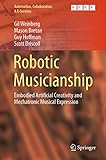Robotic Musicianship [electronic resource] : Embodied Artificial Creativity and Mechatronic Musical Expression / by Gil Weinberg, Mason Bretan, Guy Hoffman, Scott Driscoll.
By: Weinberg, Gil [author.] .
.
Contributor(s): Bretan, Mason [author.] | Hoffman, Guy [author.]
| Hoffman, Guy [author.] | Driscoll, Scott [author.]
| Driscoll, Scott [author.] | SpringerLink (Online service)
| SpringerLink (Online service) .
.
Material type:  BookSeries: Automation, Collaboration, & E-Services: 8Publisher: Cham : Springer International Publishing : Imprint: Springer, 2020Edition: 1st ed. 2020.Description: XVII, 256 p. 161 illus., 98 illus. in color. online resource.Content type: text Media type: computer Carrier type: online resourceISBN: 9783030389307.Subject(s): Acoustical engineering
BookSeries: Automation, Collaboration, & E-Services: 8Publisher: Cham : Springer International Publishing : Imprint: Springer, 2020Edition: 1st ed. 2020.Description: XVII, 256 p. 161 illus., 98 illus. in color. online resource.Content type: text Media type: computer Carrier type: online resourceISBN: 9783030389307.Subject(s): Acoustical engineeringIntroduction -- Georgia Tech’s Robotic Musicianship Platforms -- Listen Like A Human -- Play Like A Machine -- Social Interaction through Gestures -- Watch and Learn -- Wearable Robotic Musicians. .
This book discusses the principles, methodologies, and challenges of robotic musicianship through an in-depth review of the work conducted at the Georgia Tech Center for Music Technology (GTCMT), where the concept was first developed. Robotic musicianship is a relatively new research field that focuses on the design and development of intelligent music-making machines. The motivation behind the field is to develop robots that not only generate music, but also collaborate with humans by listening and responding in an expressive and creative manner. This combination of human and machine creativity has the potential to surprise and inspire us to play, listen, compose, and think about music in new ways. The book provides an in-depth view of the robotic platforms designed at the GTCMT Robotic Musicianship Group, including the improvisational robotic percussionists Haile and Shimon, the personal robotic companion Shimi, and a number of wearable robots, such as the Robotic Drumming Prosthesis, The Third Drumming Arm, and the Skywalker Piano Hand. The book discusses numerous research studies based on these platforms in the context of five main principles: Listen like a Human, Play Like a Machine, Be Social, Watch and Learn, and Wear It. .


There are no comments for this item.